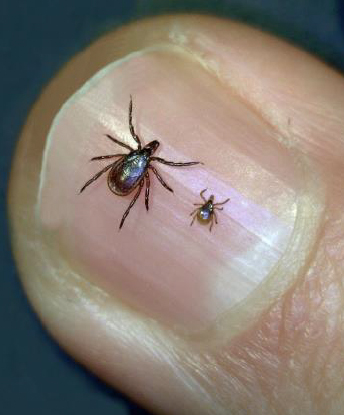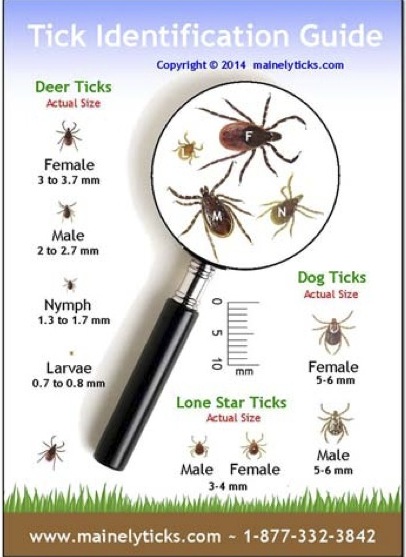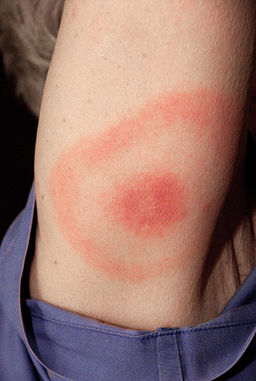A few years ago, Clayton Douglass went to his local quick care clinic to have a rash under his arm checked out. The doctor didn’t know what it was and prescribed a cream, which didn’t work. The rash spread.
Clayton spends a lot of time in the woods, so suspected he might have Lyme disease. “I’m constantly dealing with ticks,” he says. “I looked it up on the Internet and found pictures that looked exactly like what I had. I went back to the doctor, showed him the rash again and suggested that it might be Lyme disease. He looked it up in a medical journal and agreed. He then put me on a 21-day treatment of doxycycline. The rash cleared up and I haven’t had any problem since. I was lucky. Many people don’t get treatment until it’s too late. Ticks are an epidemic.”
Ticks — tiny creatures that barely tickle when they crawl over your skin. Makes me shudder just to write the sentence.
Did you know that in Maine alone, 14 different tick species have been identified? Thankfully, they don’t all feast on humans. But one, the deer tick, is responsible for most of the tick-borne illnesses in humans in this state, primarily Lyme disease.
If a tick is making a meal of you, determining if it’s a deer tick is important. This guide from Mainely Ticks is helpful because it shows actual tick sizes.
According to the Maine Medical Center Research Institute (MMCRI), about two-thirds of the cases of Lyme disease in Maine are reported in June, July, and August. That’s because the peak season for deer tick nymphs is June and July.
All stages will bite humans, but because the nymphs are tiny and their bite painless, they often get missed.
Adult ticks hang around well into the fall, so it’s important not to let your guard down even come November.
Lyme disease, which is a bacterial infection carried by the deer tick, is rampant in Maine, but a deer tick can also transmit anaplasmosis and babesiosis, as well as a virus that has health officials on alert — Powassan. Strains of the Powassan virus are also carried by the squirrel tick and the woodchuck tick.
Powassan is rare at this point — only 60 cases have been reported in the United States over the past 10 years, including five in Maine.
The problem is that it can cause inflammation of the brain (encephalitis), which can leave a person with permanent neurological damage or, in 10 to 15 percent of cases, cause death.
To help determine the prevalence of Powassan-carrying ticks in Maine, MMCRI just received a grant that, according to Bangor Daily News, will enable its researchers to “collect ticks from across the state to test for the virus, providing a baseline for monitoring the prevalence of Powassan in the tick population going forward.”
As for what we can do, it’s critical to always check yourself, your children and grandchildren and your pets thoroughly after being outdoors. Something I recently discovered: Lyme disease is most common among school-age children and adults over 65.
If you find a tick, the sooner you remove it, the less likely you’ll get a tick-borne illness.
How to remove a tick
Using tweezers
- Grasp the tick close to the skin with fine-tipped tweezers.
- Pull gently upward with steady, even pressure until the tick lets go.
- Try not to squeeze, crush or puncture the body of the tick, because its bodily fluids may contain infection-causing organisms.
- After removing, thoroughly clean the bite area and your hands with rubbing alcohol or soap and water.
- Don’t use Vaseline, alcohol or nail polisher remover because they don’t work.
- Save the tick in a small bottle in case it needs to be identified. Mark it with the date and where it was attached.
- Consult a physician if you removed an engorged tick or if you develop a rash or fever within several weeks of removing the tick.
Using a tick removal spoon
- Put the notch on the spoon on the skin near the tick.
- Apply downward press and slide spoon forward to frame the tick. Keep sliding spoon forward to detach the tick.
- After removing, follow same steps as above.
If you find any ticks on you, try not to freak out, but again, do remove them promptly. To have a tick identified, (at no charge,) you can mail the specimen or upload a picture of it to the Tick Id Lab in Orono. (The lab only identifies the type of tick, not any disease it might carry.)
If you’re worried that you might have a tick-borne illness, it’s important to contact a healthcare provider.
Lyme disease symptoms
In most cases, a deer tick needs to be attached for 24 to 48 hours before it can transmit Lyme disease.
Stage 1 symptoms of Lyme disease (usually occur within three to 30 days)
- Chills
- Fever
- Headache
- Lack of energy
- Achy joints or muscles
- Rash that resembles a bull’s eye (an estimated 70% to 85% will get a rash)
Stage 2 symptoms of Lyme disease (one to four months)
- Tiredness
- Additional rashes
- Pain, weakness or numbness in the arms or legs
- Paralysis of nerves in the face
- Recurring headaches or fainting
- Poor memory, inability to concentrate
- Conjunctivitis
- Occasional rapid heartbeats
Stage 3 symptoms of Lyme disease (several months or years)
- Joint swelling, especially the knees
- Numbness and tingling in hands, feet or back
- Severe fatigue
- Neurologic changes
- Chronic Lyme arthritis
Lyme disease is easily treated in the early stages with antibiotics, which are also used to treat later stages of the disease. There used to be a vaccine available, but it was taken off the market in 2002, supposedly because there wasn’t enough demand.
Powassan virus symptoms
It appears that the Powassan virus can be transmitted from tick to human in as little as one hour. Symptoms may occur from two days to two weeks after a bite.
There is no telltale rash and many people who become infected don’t develop any symptoms. If they do, they can include:
- Fever
- Headache
- Vomiting
- Weakness
- Confusion
- Loss of coordination
- Speech difficulties
- Seizures
Treatment
Currently, there is no vaccine to prevent Powassan or medications to treat an infection. Encephalitis is generally treated with supportive care and medicine to reduce swelling in the brain
Tick emergency preparedness
In the words of Ben Franklin, “An ounce of prevention is worth a pound of cure.” That includes trying to protect yourself against ticks in the first place.
- Try to avoid known tick-infested areas and if you can’t, plan activities for hottest, driest part of the day.
- Wear light-colored clothing.
- Wear long pants tucked into socks or boots and tuck shirt into pants.
- Don’t wear open-toed shoes or sandals in areas that may harbor ticks.
- Consider using a tick repellent. For more information, read this insect repellent fact sheet.
- Check yourself over carefully after you’ve been outdoors and make sure to look under your arms, behind the knees, between the legs, in and around the ears, in the belly button and in the hair.
You don’t have to be out in the back woods to come head to head with a tick. Most likely it’ll happen right in your own backyard.
Clayton Douglass says he hasn’t found anything yet that does a good job of repelling ticks. “I do use DEET,” he says, “but I think it only cuts down on the numbers of them I find. A couple of years ago I went deer hunting off the Webb Road in Windham. When I got back to my truck, I started picking off little black deer ticks. I counted over thirty of them! I’ve heard people say that part of the problem is people don’t burn their fields like they used to 40-50 years ago. I don’t know the answer. DDT used to kill a lot of them, but I’m still glad they stopped spraying that stuff around. I see a lot of eagles now. I’ll deal with the ticks to enjoy that sight!”
Do you have any advice to share?
Have you found a way to protect yourself against ticks? Let me know what works best.





Anyone that wants more information can watch the series of brief informative videos with current scientifically-validated information about Lyme disease and other tick-borne diseases that can be found at http://www.youtube.com/user/LymeActionNetwork .
Thanks Jeff!
http://www.caryinstitute.org/newsroom/opossums-killers-ticks
Julie, thank you for the link. I just read another article about opossums and how much they like to eat ticks. Bring ’em on!
Thank you Diane for an excellent read on Tick Borne Disease!
Thanks Poppy!